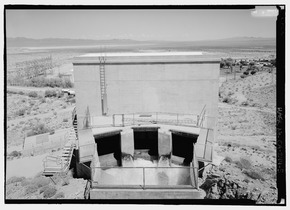Turtle Mountains (California) facts for kids
Quick facts for kids Turtle Mountains |
|
|---|---|

(view due east)
Turtle Mountains at left across Ward Valley & Danby Lake. (view from southeast Iron Mountains) |
|
| Highest point | |
| Elevation | 960 ft (290 m) |
| Geography | |
| Country | United States |
| State | California |
| District | San Bernardino County |
| Topo map | USGS Mopah Peaks |
| Type | NNL |
| Date | 1973 |
The Turtle Mountains are a beautiful mountain range in southeastern California. They are found in northeastern San Bernardino County. The local Mojave language name for them is Amat 'Achii'ar.
These mountains show off many colors, from deep reds and browns to tans, grays, and even black. You can find many natural springs and wet areas here. The Turtle Mountains are also a special place called a National Natural Landmark. This means they have amazing natural features.
Contents
Exploring the Turtle Mountains' Location
The Turtle Mountains are about 30 miles (48 km) southwest of Needles, California. They are located west of U.S. Highway 95. Nearby towns include Vidal Junction to the southeast and Blythe to the south.
These mountains are part of the larger Lower Colorado River Valley area. They sit directly west of the Mopah Range and are connected to it. The range runs mostly north–south. To their east are the Ward Valley and the Old Woman Mountains. The Whipple Mountains and the Colorado River are to their west. The highest point in the Turtle Mountains is Bolson Peak, which reaches 4,231 feet (1,289 meters) above sea level.
Understanding the Mountains' Geology
The Turtle Mountains are part of a group of ranges called the Maria Fold and Thrust Belt. This area experienced major changes in its rocks over millions of years.
During the Cretaceous period, the Earth's crust here was squeezed from north to south. This was unusual because most of North America was being squeezed from east to west at that time. Later, in the Miocene period, the crust stretched out from east to west. These movements shaped the mountains we see today.
Discovering the Turtle Mountains Wilderness
The Turtle Mountains Wilderness was created in 1994 by the U.S. Congress. This protected area covers 177,309 acres. It includes wide, gently sloping areas called bajadas, along with sharp volcanic peaks, spires, and cliffs.
The U.S. Bureau of Land Management takes care of this wilderness. To the north, it borders the Stepladder Mountains Wilderness.
Wildlife and Plants of the Turtle Mountains
The Turtle Mountains are a special place for plants and animals. They are located where the Mojave Desert (also known as the High Desert) meets the Colorado Desert region of the Sonoran Desert (the Low Desert). This mix of environments means you can find many different kinds of species here.
For example, the endangered California fan palm reaches the northernmost part of its range in the Mopah-Turtle Mountains. This means it doesn't grow any farther north than this area.
The main plants you'll see are the creosote bush and bur sage. You'll also find creosote bush and the palo verde-cactus shrub. In the dry riverbeds, called washes, you can find woodlands with trees like smoke tree, honey mesquite, and catclaw.
Many animals live in this wilderness. These include:
- Desert bighorn sheep
- Coyotes
- Black-tailed jackrabbits
- Ground squirrels
- Kangaroo rats
- Quail
- Roadrunners
- Golden eagles
- Prairie falcons
- Rattlesnakes
- The desert tortoise
- Several types of lizards
Fun Activities in the Wilderness
The Turtle Mountains Wilderness is a great place for outdoor adventures. You can enjoy many activities here:
- Hiking
- Horseback riding
- Camping
- Rock hounding (looking for cool rocks)
- Photography
- Backpacking
The area is very popular with people who love to collect rocks. It's famous for special chalcedony rocks called "Mopah roses." Natural palm oases like Coffin, Mopah, and Mohawk Springs are popular spots for hikers to visit.


